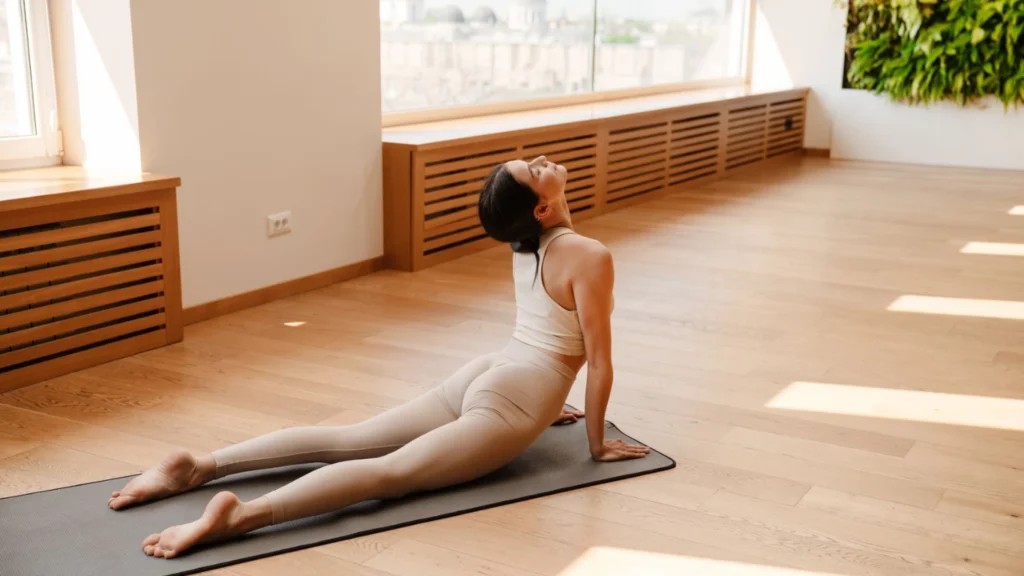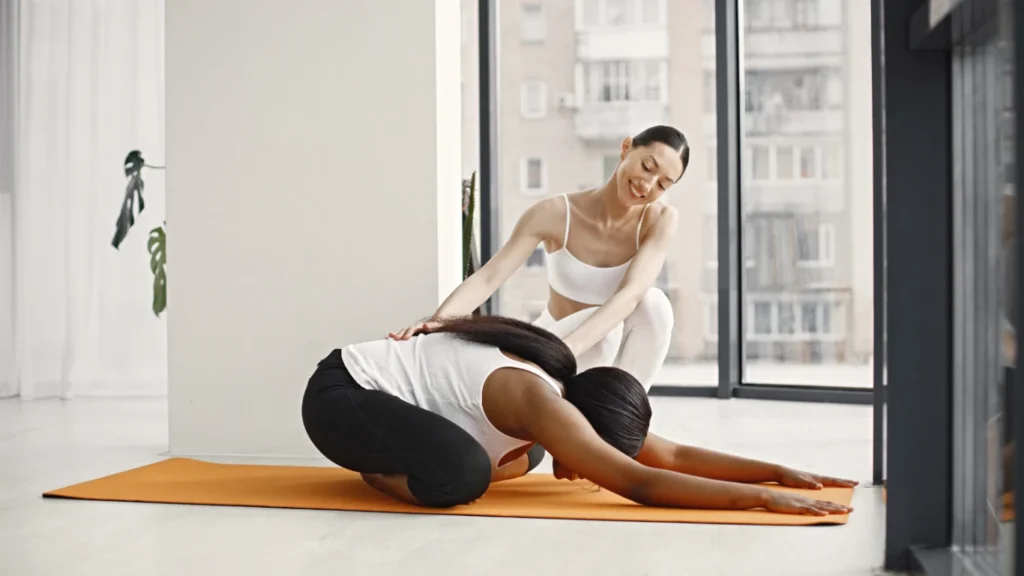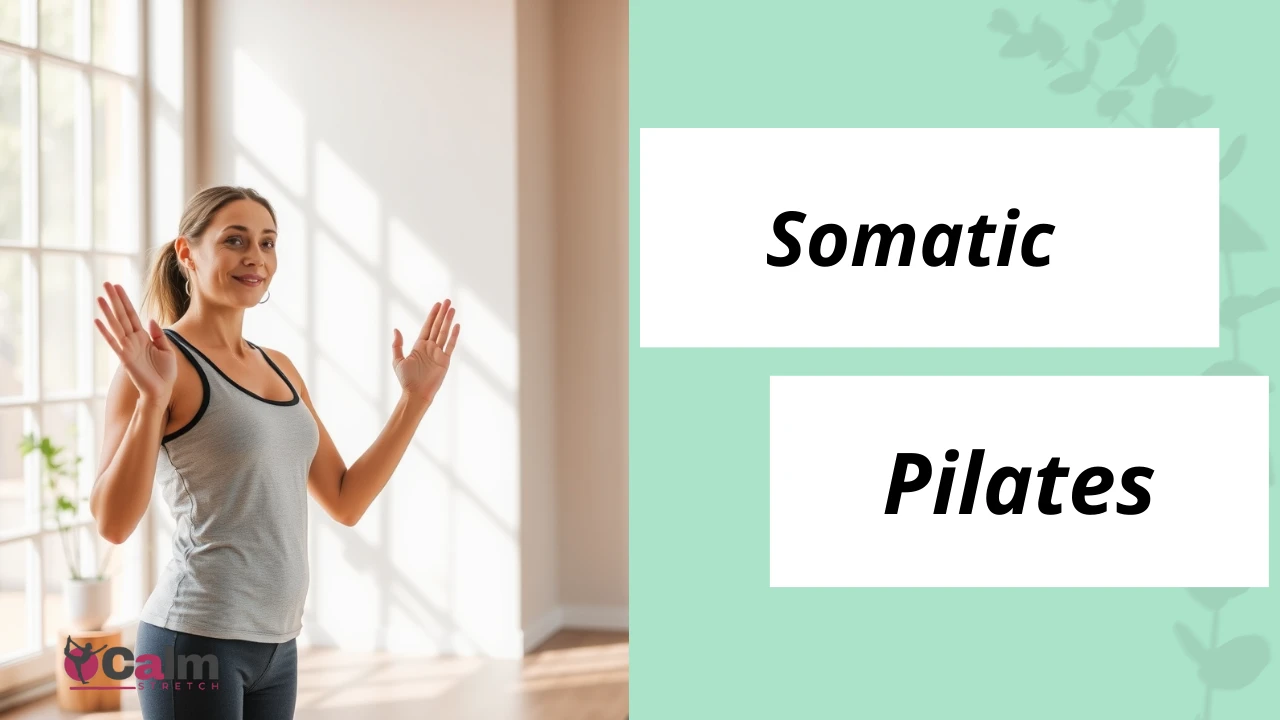Somatic Pilates is a way of moving that combines Pilates exercises with paying close attention to how my body feels. While Pilates helps build strength and improve posture, Somatic Pilates helps me notice my body’s sensations as I move. This practice lets me release tension, become more flexible, and move more gently.
Just like somatic yoga, which also focuses on being aware of the body and finding relaxation, Somatic Pilates helps me lower stress and feel more connected to myself. So, does somatic yoga work? Yes, it does! Like Somatic Pilates, it helps me feel less tense and improves my overall well-being.
The word “somatic” comes from a Greek word soma, which means “the body.” Somatic Pilates encourages you to not just focus on doing the exercises, but also to feel what’s happening in your body during each movement.
| Fact | Details |
|---|---|
| Who Can Do It | Anyone, no matter your age or fitness level. It’s especially good for people with pain, recovering from injuries, or stress. |
| What It Focuses On | It combines Pilates exercises with paying attention to how your body feels while moving. |
| Main Benefits | Better posture, less pain, more flexibility, improved movement, and relaxation. |
| How It Differs from Regular Pilates | It focuses on how you feel inside your body, not just on getting the right form or position. |
| What It Helps With | Pain, stiffness, stress, anxiety, joint problems, and injury recovery. |
| Speed of Movement | Movements are slow and focused, not fast or rushed. |
| Class Length | Classes usually last 45 to 60 minutes. |
| How Often to Practice | 2-3 times a week is a good amount for most people. |
| What You Need | Just a mat. Sometimes small tools like foam rollers or bands are used to help release muscle tension. |
| Mental Health Benefits | Helps reduce stress, relax, and improve how you feel in your body. |
| Intensity | It’s a low to moderate intensity practice, focusing on gentle movements rather than tough exercises. |

Understanding Somatic Movement
Somatic movement is about paying close attention to how your body feels as you move. It’s about going slow, listening to your body, and being aware of your muscles and joints. In Somatic Pilates, these ideas mix with Pilates exercises, helping you build strength and flexibility while also focusing on your body’s sensations.
How Somatic Principles Integrate with Pilates
Traditional Pilates focuses on exercises that strengthen your body and improve your posture. Somatic Pilates still uses these exercises but adds an extra layer—body awareness. Instead of just focusing on doing the exercise right, Somatic Pilates encourages you to notice how each movement feels and make adjustments if needed. This helps release tension and makes your movements smoother.
Goals of Somatic Pilates
Improving Posture and Alignment
Somatic Pilates helps you learn how to align your body better. It teaches you to engage your muscles in a way that helps you stand and sit taller, which reduces strain on your spine.
Reducing Chronic Pain and Tension
If you have ongoing pain or muscle stiffness, Somatic Pilates can help. By moving slowly and gently, it helps release tightness in muscles and reduces pain over time.
Improving Flexibility and Mobility
Somatic Pilates helps stretch and strengthen your body in a safe, controlled way. It can improve your flexibility without pushing too hard.
Promoting Relaxation and Mental Clarity
In addition to physical benefits, Somatic Pilates also helps calm your mind. The focus on deep breathing and gentle movements helps reduce stress and clear your mind.
How Somatic Pilates Differs from Traditional Pilates
While both Somatic Pilates and traditional Pilates work on strength, flexibility, and posture, they differ in how they focus on your body:
Focus on Internal Awareness vs. External Form
Traditional Pilates focuses on getting your body into the right shape or position. Somatic Pilates, however, focuses on how each movement feels. Instead of pushing your body into perfect form, it encourages you to listen to your body and move in a way that feels right for you.

Who Can Benefit from Somatic Pilates?
Somatic Pilates is for everyone! It’s especially helpful for:
- People with chronic pain: It’s great for relieving ongoing tension, especially in the back, neck, and joints.
- People recovering from an injury: It helps rebuild strength and mobility slowly and carefully.
- People with stress: The gentle, mindful movements can calm your mind and reduce stress.
- Anyone looking for a gentle, mindful workout: If you want to move slowly and focus on how your body feels, Somatic Pilates is a great option.
Getting Started with Somatic Pilates
If you’re new to Somatic Pilates, try finding a teacher who understands the link between movement and body awareness. Start with simple movements, paying attention to your breath and how your body feels. As you practice, you’ll get better at listening to your body and noticing where you need more flexibility or strength.
Recap: Why Somatic Pilates Might Be Right for You
Somatic Pilates is a gentle but effective way to improve strength, flexibility, and overall well-being. It’s perfect for people dealing with chronic pain, recovering from injuries, or simply wanting to feel more connected to their bodies. By combining Pilates with body awareness, it helps you feel more relaxed, aligned, and in touch with your body, offering long-lasting health benefits.
Conclusion
Somatic Pilates offers a unique approach to fitness by blending the strength-building exercises of Pilates with the mindfulness of somatic movement. It’s an excellent practice for anyone looking to improve their posture, reduce pain, increase flexibility, and promote relaxation. By focusing on how your body feels during movement rather than striving for perfect form, Somatic Pilates helps create a deeper connection to your body and mind. Whether you’re new to exercise or looking for a gentler, more mindful workout, Somatic Pilates can be a powerful tool for enhancing your overall health and well-being.
FAQ’s
What is Somatic Pilates?
Somatic Pilates is a gentle workout that mixes Pilates exercises with paying attention to how your body feels. It helps you get stronger, more flexible, and relaxed while also reducing pain and stress.
How is Somatic Pilates different from regular Pilates?
Traditional Pilates focuses on doing exercises in a specific way to build strength and improve posture. Somatic Pilates is more about how each movement feels in your body, helping you release tension and move mindfully.
Who can benefit from Somatic Pilates?
Anyone can do Somatic Pilates! It’s especially good for people with pain, stress, anxiety, or those recovering from an injury. It’s a gentle way to improve flexibility and strength, no matter your fitness level.
Do I need special equipment for Somatic Pilates?
No, you don’t need much. A comfortable mat is enough. Sometimes, small tools like foam rollers or bands are used, but they are not always necessary.
How often should I practice Somatic Pilates?
It’s best to practice 2-3 times a week for the best results. But always listen to your body and practice at a pace that feels comfortable for you.


2 Responses
I love how it emphasizes both physical and emotional healing through mindful movement. The focus on body awareness, breath, and core strength makes it feel like a holistic practice. It’s definitely a great option for anyone looking to improve flexibility and reduce stress. Excited to give it a try
Thank you for your thoughtful comment! I’m so glad you found the approach of mindful movement and body awareness inspiring. It really is a holistic practice that can make a big difference in both physical and emotional well-being. Wishing you all the best as you give it a try – hope you enjoy the journey.